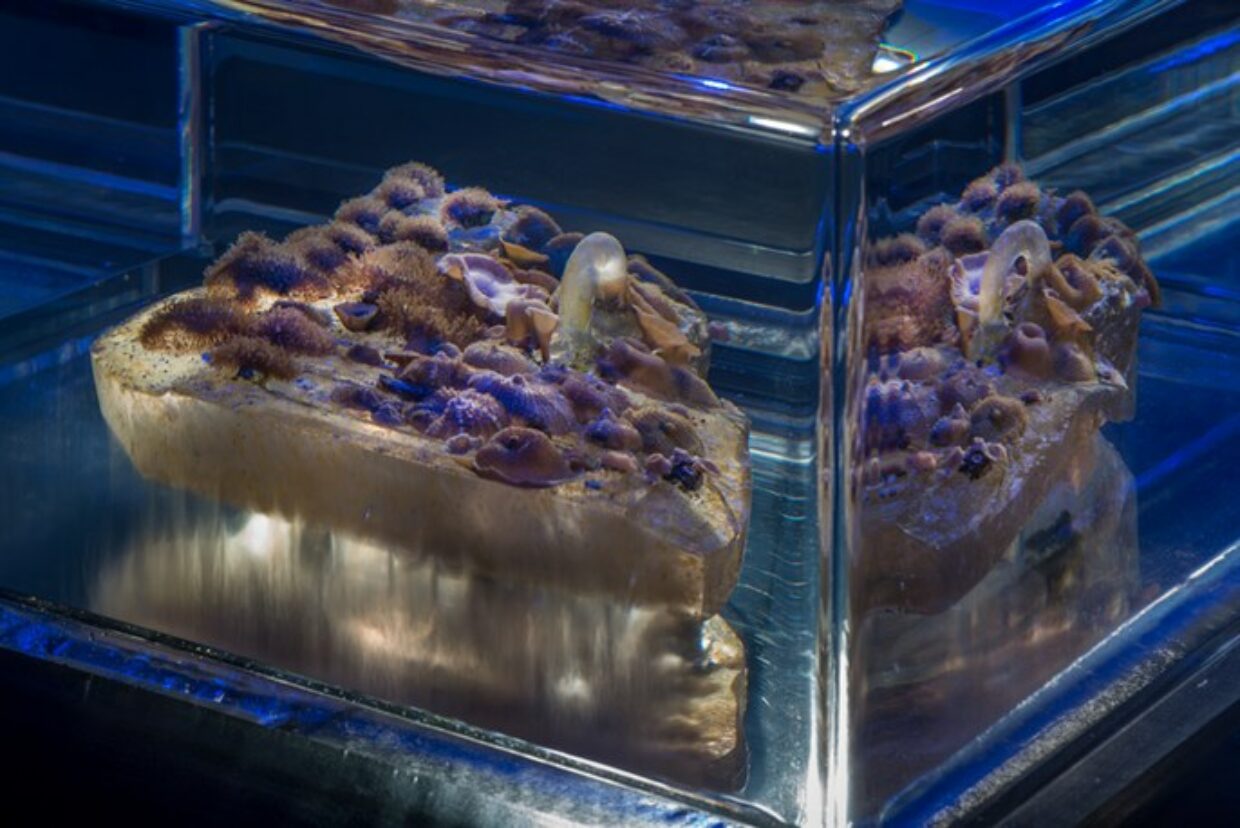Glenn Kaino’s “Tank” Exhibition at Grand Arts
May. 20, 2015
Art and science, philosophy and activism converge in Glenn Kaino’s “Tank,” the current exhibition at Grand Arts.
The installation achieves seductive visual splendor within the darkened space of the gallery, which presents 10 sleek, square, zero-edge aquarium tanks, brimming with clear water, elevated on simple platforms and glowing with bluish-white light from suspended lamps.
The tanks harbor colorful groupings of coral, small marine invertebrates that in nature grow to form ocean reefs. Each tank holds several coral species — more than 100 in all — varying tremendously in appearance and displaying an array of vibrant hues.
These colors belong not to the translucent coral polyps, however, but to the millions of microscopic algae they host in a symbiotic relationship. The 42-year-old Los Angeles artist aptly calls these visually arresting clusters of aquatic life “living paintings.”
The coral in Kaino’s tanks rise from thick chunks of resin that give the exhibition title a double meaning: the resin pieces were cast from parts of a decommissioned M60 main battle tank.
The idea of growing coral this way as an art project came to Kaino in the mid-1990s when he learned of Reef-Ex, an ongoing effort involving the Department of Defense, National Guard, and federal and state environmental agencies through which surplus tanks are dumped into coastal waters to create artificial reefs, providing habitats for coral, fish, and other marine life.
“I wanted to create a living artwork that would represent the poetic paradox of some of the world’s tiniest organisms reclaiming instruments of some of the largest,” Kaino explained to Artforum.
This idea remained filed away in his mental bank of “impossible projects” until a 2011 conversation with Grand Arts Artistic Director Stacy Switzer that led to the realization of “Tank” with financial backing from Grand Arts.
Kaino engaged with scientists to develop the project, consulting with marine biologists and coral hobbyists to learn about coral reef husbandry. He then teamed with Aquamoon, a Chicago-based aquarium-design studio and aquatics laboratory, to devise the custom-built system for the sustenance and optimal display of the coral.
Prior to its presentation at Grand Arts, a smaller version of “Tank” debuted at “Prospect.3,” the international contemporary art triennial in New Orleans.
In that installation, the equipment necessary for the circulation, filtration, and temperature control of the work’s water was exposed to view, which Kaino found distracting. At Grand Arts, this infrastructure is in the basement, connected to the tanks through holes in the concrete floor, creating ideal conditions for the unimpeded contemplation of the coral groupings.
Through its references to Reef-Ex, “Tank” prompts philosophical musings on the paradox of new life taking root on discarded machines of war. As Kate Hackman observes in her eloquent brochure essay, the coral at the work’s heart may, on one level, represent “a fundamental assertion of hope, renewal, and the will to live: the possibility of growth in the wake of death, of regeneration following destruction.”
Complicating this reading, however, is another paradox: The different coral species in each tank are engaged in their own life-and-death battles for territory, attacking each other through the emission of toxins or tentacle stings.
Kaino, in his artist’s talk, likened the appearance of the denser coral groupings to maps, with “colonial formations that fight at the borders and look like nation states.”
In nature a much larger threat looms over all coral species. The International Coral Reef Initiative predicts that most of the world’s reefs will disappear over the next century, seriously affecting the lives of 500 million people, 30 million of whom depend primarily on reefs for their livelihood. Through climate change, pollution and overfishing, the world has seen a rapid demise of coral reefs and a loss of marine biodiversity.
For residents of the American heartland to whom such concerns may seem distant and abstract, Kaino’s “Tank” brings coral into the gallery and frames them as works of art, inviting us to closely examine these fascinating life forms and to sense the artist’s understated but undeniable activist agenda.
“Tank” not only beckons us to enjoy the seductive beauty of its “living paintings” but also seeks to raise our awareness of their precarious existence in the wild, quietly calling us to action to help preserve their environment — and ours.
David Cateforis is professor of art history at the University of Kansas.
Source: The Kansas City Star

